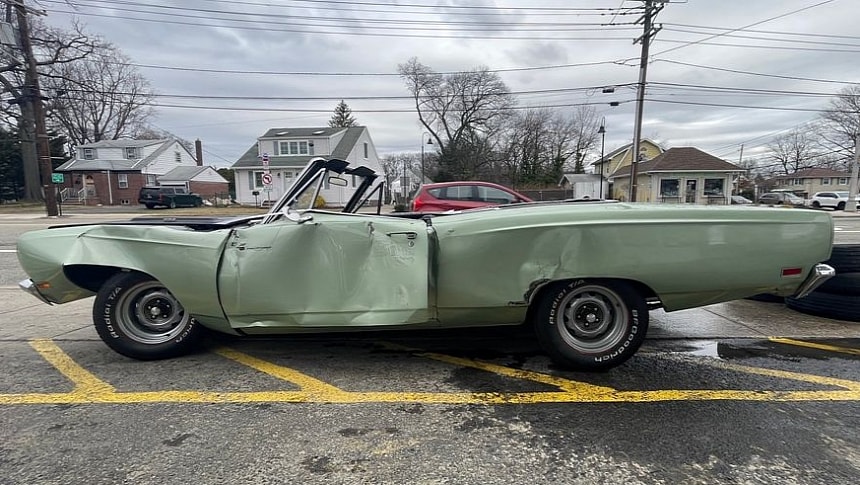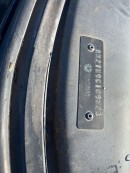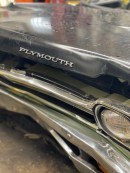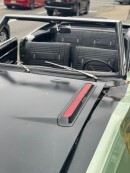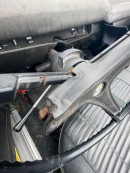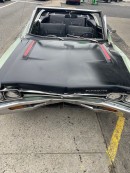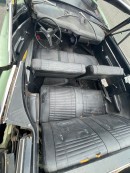When it comes to derelict classic cars, we keep talking about barn finds and junkyard-bound rust buckets. Well, this 1969 Plymouth Road Runner proves that a restored oldtimer can also get into trouble. Once a gorgeous drop-top, this Mopar is now a wrecked B-body needing assistance.
There's no info on what exactly happened, but it looks like this Road Runner hit something hard enough to bend all body panels except for the rear fenders. The front fascia is completely mangled, the doors won't close, and the dashboard has been reshaped into something barely recognizable. The steering column is crooked, as is the front bench seat. Hopefully, no one was injured in this crash.
Despite all these issues, we're told the V8 engine still runs. It probably needs a new radiator and a thorough checkup, but the engine bay looks surprisingly good. And based on the appearance of the 383-cubic-inch (6.3-liter) V8, this Road Runner may sport a numbers-matching unit. The VIN confirms it is a 383 big-block car with a three-speed automatic.
While the engine itself isn't rare, the convertible body style makes this Road Runner quite scarce. 1969 was the nameplate's most successful model year, with 81,105 units sold. No fewer than 78,906 examples were ordered with the 383-cubic-inch V8. However, convertible production was only a small fraction of the total output. Specifically, Plymouth assembled just 1,890 drop-tops.
Ten rolled off the assembly line with the range-topping 426-cubic-inch (7.0-liter) HEMI, leaving us with 1,880 vehicles fitted with the 383. The automatic transmission narrows it down to 1,111 examples. This number is low enough to feel sorry for this Road Runner, especially since fewer than 200 may still run and drive today.
So, is this Mopar worth restoring? Well, it isn't easy to estimate how much that will cost without a proper inspection inside and out, but it's safe to say this Road Runner needs to be completely restored before it returns to the road. There's no way you can safely drive this convertible without taking it apart first.
That said, this so-called "great project car" will swallow a lot of cash, perhaps even more than its market value in Concours-ready condition. While rare, these drop-tops don't command a lot of dough unless they have a HEMI under the hood. A quick look at recent auction results reveals that 383 V8 examples in very good condition rarely go for more than $70,000.
All told, this project would have to be a labor of love more than a restoration meant to bring big bucks at auction. But I think this Road Runner deserves a second chance, and I hope someone returns it to public roads. If it's the kind of project you're looking for, the seller wants $14,900 to let it go, which is a bit high if you ask me.
Despite all these issues, we're told the V8 engine still runs. It probably needs a new radiator and a thorough checkup, but the engine bay looks surprisingly good. And based on the appearance of the 383-cubic-inch (6.3-liter) V8, this Road Runner may sport a numbers-matching unit. The VIN confirms it is a 383 big-block car with a three-speed automatic.
While the engine itself isn't rare, the convertible body style makes this Road Runner quite scarce. 1969 was the nameplate's most successful model year, with 81,105 units sold. No fewer than 78,906 examples were ordered with the 383-cubic-inch V8. However, convertible production was only a small fraction of the total output. Specifically, Plymouth assembled just 1,890 drop-tops.
Ten rolled off the assembly line with the range-topping 426-cubic-inch (7.0-liter) HEMI, leaving us with 1,880 vehicles fitted with the 383. The automatic transmission narrows it down to 1,111 examples. This number is low enough to feel sorry for this Road Runner, especially since fewer than 200 may still run and drive today.
So, is this Mopar worth restoring? Well, it isn't easy to estimate how much that will cost without a proper inspection inside and out, but it's safe to say this Road Runner needs to be completely restored before it returns to the road. There's no way you can safely drive this convertible without taking it apart first.
That said, this so-called "great project car" will swallow a lot of cash, perhaps even more than its market value in Concours-ready condition. While rare, these drop-tops don't command a lot of dough unless they have a HEMI under the hood. A quick look at recent auction results reveals that 383 V8 examples in very good condition rarely go for more than $70,000.
All told, this project would have to be a labor of love more than a restoration meant to bring big bucks at auction. But I think this Road Runner deserves a second chance, and I hope someone returns it to public roads. If it's the kind of project you're looking for, the seller wants $14,900 to let it go, which is a bit high if you ask me.
